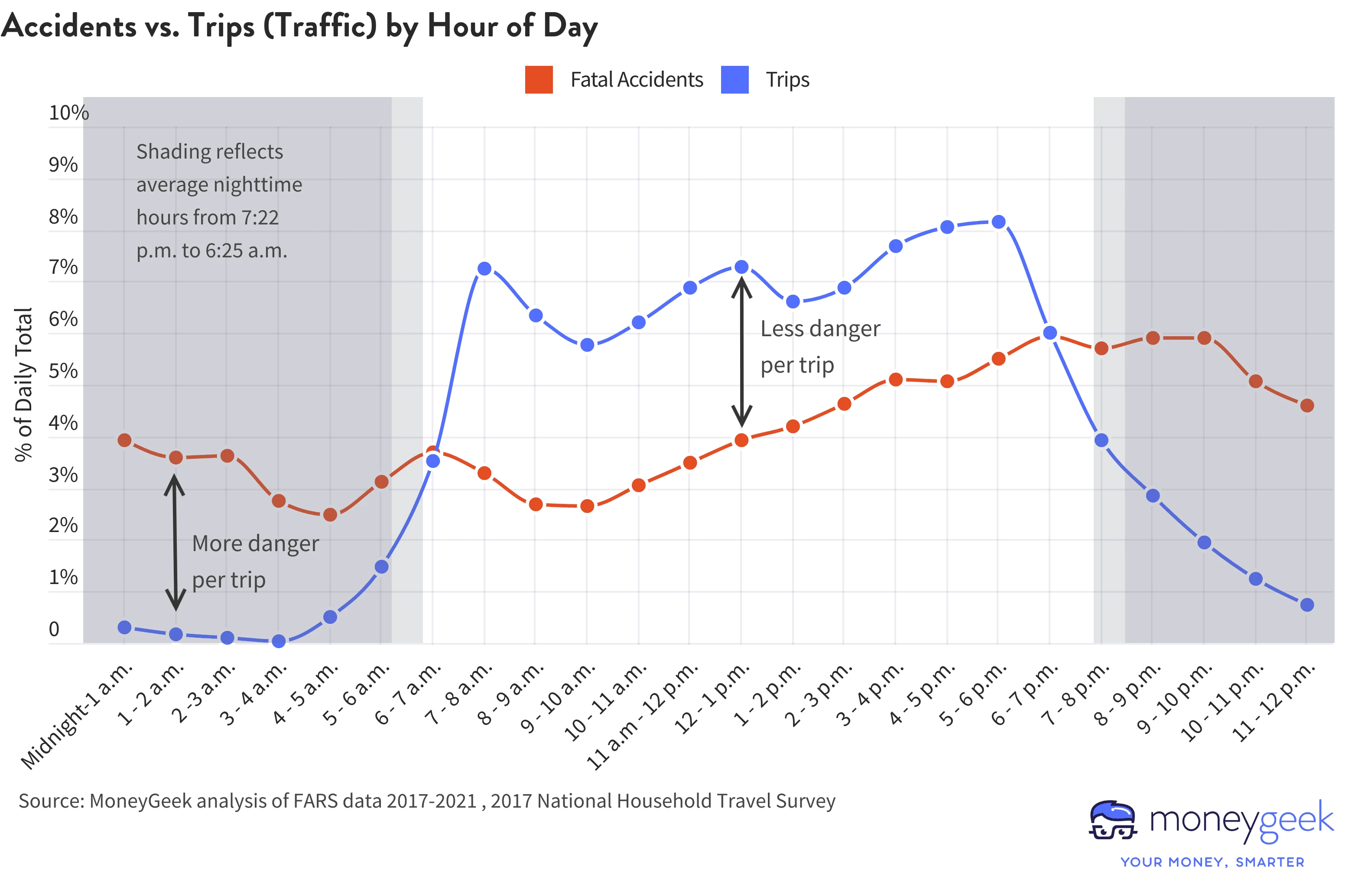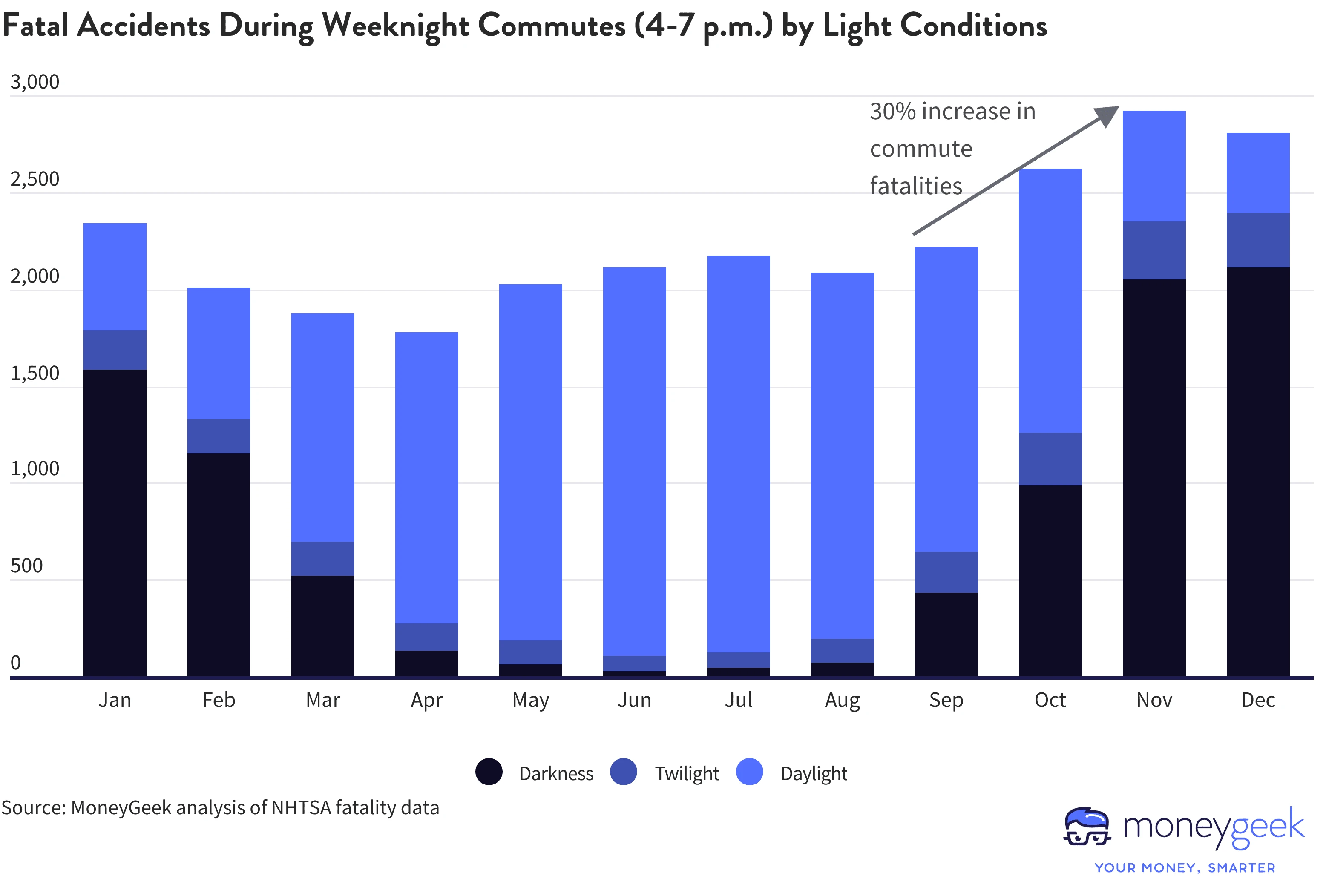MoneyGeek analyzed data from the Bureau of Transportation Statistics and the National Highway Traffic Safety Administration (NHTSA) found that driving at night, defined as the period from sunset to sunrise, is nine times deadlier than driving during the day. We also explored the impact that transitioning from daylight saving time to standard time had on the safety of evening commute and the relative danger of night driving by state.
Driving at Night Is 9 Times Deadlier Than Driving During the Day
Driving at night is nine times more dangerous than during the day, based on fatal accident rates relative to traffic volume.
MoneyGeek is dedicated to providing trustworthy information to help you make informed financial decisions. Each article is edited, fact-checked and reviewed by industry professionals to ensure quality and accuracy.
Editorial Policy and StandardsUpdated: November 1, 2024
MoneyGeek is dedicated to providing trustworthy information to help you make informed financial decisions. Each article is edited, fact-checked and reviewed by industry professionals to ensure quality and accuracy.
Editorial Policy and StandardsUpdated: November 1, 2024
Advertising & Editorial Disclosure
-
Night driving is nine times more lethal than daytime driving, considering the number of fatal accidents relative to traffic volume.
-
Night driving risk is highest for drivers in California and Hawaii; there, nighttime driving is 12 times more deadly than daytime driving.
-
Evening commutes become 30% more hazardous from September to November, primarily due to darker lighting conditions and the transition from daylight savings to standard time.
Comparing the Danger of Night Driving to Day Driving
MoneyGeek's analysis found that while just 9% of driving occurs from sunset to sunrise, 49% of fatal accidents occur during this time. In contrast, 83% of driving happens during daylight hours, with 47% of deadly crashes occurring during the day. Even though roughly the same number of fatal accidents occur during both day and night, significantly fewer instances of night driving indicate that nighttime trips are nine times more deadly than daytime trips.
Time of Day | % of Trips | % Fatal Accidents |
|---|---|---|
Dawn | 4% | 2% |
Daytime | 83% | 47% |
Dusk | 4% | 2% |
Night | 9% | 49% |
On an hour-by-hour basis, fatal accidents are at their low at 9 a.m. and ramp up throughout the day, peaking between 8 p.m. and 10 p.m.

MoneyGeek's analysis found that nighttime driving is nine times more deadly than daytime driving, but why is this? Several factors make night driving hazardous, including:
-
Reduced Visibility. While driving at night, the lack of light reduces visibility and gives drivers less time to react to signs, wildlife and pedestrians.
-
Drowsy Driving. It’s natural for people to get tired at night. According to the NHTSA, drowsy driving accidents happen most between midnight and 6 a.m.
-
Drunk Driving. Analysis of fatal accidents found that 70% of drunk driving crashes that result in deaths happen at night. Overall, about 1 in 4 fatal accidents during nighttime are related to drunk driving.
Shifting to Standard Time Coincides With Increased Driving Deaths During Evening Commutes
During the fall, drivers on their weekday commutes face an annual double darkness jeopardy — dwindling sunlight as the days shorten and an overnight shift back to standard time. MoneyGeek's analysis of weekday commute driving fatalities found that fatalities typically surge 30% from September to November, correlated to an increase in fatal accidents at night.
Falling back from daylight savings to standard time in November means evening commutes can have up to a full hour less of daylight. To give you a sense of what this means in terms of driving danger: The share of fatal accidents in darkness is 37% in October, but that number jumps to 69% in November. MoneyGeek reviewed the change in commute fatalities from October to November to isolate the impact of changing back to standard time and found that crash deaths increased by 11% from October to November, indicating the effect of the standard time.

MoneyGeek's analysis also found that increases in fatal driving rates at night varied greatly by state, with some surprising findings. In Arizona — a state that doesn't observe daylight savings — fatal accidents still rise by 17% from September to November, underscoring the impact of shorter days. On the other hand, Florida and Texas experienced an increase in fatal accidents of over 70% during the same period.
Night Driving Danger Varies by State
MoneyGeek also investigated if driving at night is deadlier in some states than others. While night driving is more dangerous than day driving in every state, the range of danger varies. California and Hawaii have the highest risk associated with nighttime driving: there, driving at night is 12 times more dangerous than driving during the day. In contrast, Vermont has the smallest difference in night and day driving fatalities: in that state, nighttime driving is only 3.7 times more dangerous than daytime driving.
12 Most Dangerous States for Nighttime Driving
State | Night Driving
Increased Risk of
Deadly Accidents | |
|---|---|---|
1. | California | 12.1 |
2. | Hawaii | 12.0 |
3. | Florida | 11.2 |
4. | Texas | 10.8 |
5. | Maryland | 10.6 |
6. | Louisiana | 10.2 |
7. | New Jersey | 9.8 |
8. | South Carolina | 9.7 |
9. | Rhode Island | 9.5 |
10. | Nevada | 9.2 |
11. | Delaware | 9.2 |
12. | Connecticut | 9.2 |
Staying Safe and Protected While Driving at Night
Nighttime driving involves significantly more risk than daytime driving. While you can't account for all of these potential hazards, there are a variety of tactics you can use to stay safe on the road at night, including:
The slower you are going, the more time you have to react. While it's important that you don't drive below the speed limit, driving at the speed limit can help you offset some of the visibility issues present at night.
Working headlights are critical for increasing visibility. At the same time, make sure your cabin lights are dimmed appropriately at night to preserve your night vision. If you can drive a well-lit road versus one that is unlit, it's likely to be safer to drive the lit street.
The best way to do this is to plan your trip to ensure you're not driving while tired. If you're feeling drowsy, find a way to stop and rest to recharge so you can remain alert on the road. And remember, never drink and drive.
Failing to follow these safety measures can have serious consequences. Not only does it increase your risk of accidents, but it can also have a significant financial impact. Your insurance rates could increase by 67% after an accident.
In addition to driving safely, it's crucial that you have car insurance from a reputable auto insurance company in the event of an accident. Accidents caused by drowsy driving often involve drivers hitting obstacles, not other cars. While minimum coverage and liability-only policies won't cover your vehicle if you're deemed at fault, full coverage policies will.
Methodology
MoneyGeek analyzed 93,554 driving fatalities reported by the NHTSA in the Fatal Accident Reporting System (FARS) from 2017 to 2021, the most recent year of data available.
Night versus day designations in the FARS system are recorded directly in the data set as the light conditions for each accident.
Trip data was collected from the Bureau of Transportation Statistics’ 2017 National Household Travel Survey. Trip times were translated to day, night, dawn and dusk using the NOAA’s solar calculator and the population center of the United States: Hartville, Missouri. Taken over a full year, the analysis found that the daylight by location in the United States is approximately the same.
About Doug Milnes, CFA

Doug Milnes is the head of marketing and communications at MoneyGeek. He has spent more than a decade in corporate finance performing valuations for Duff and Phelps and financial planning and analysis for various companies, including OpenTable. He holds a master’s degree in Predictive Analytics (Data Science) from Northwestern University and is a CFA charter holder. Doug geeks out on building financial and predictive models and using data to make informed decisions.
sources
- Bureau of Traffic Statistics. "National Household Travel Survey." Accessed November 1, 2024.
- National Highway Traffic Safety Administration. "Drowsy Driving." Accessed November 1, 2024.
- National Highway Traffic Safety Administration. "Fatal Accident Reporting System." Accessed November 1, 2024.
- National Oceanic and Atmospheric Administration. "NOAA Solar Calculator." Accessed November 1, 2024.
